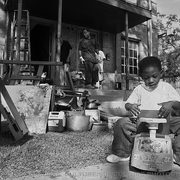-
Two years after Hurricane Katrina drastically accelerated the already-in-place systematic marginalization of communities of color on the Gulf Coast, those communities are still fighting for a just and sustainable recovery, while also creating innovative work that combines environmental, social, and economic justice.
The devastation following Hurricane Katrina, and the government’s failure to respond to a disaster affecting a mostly African-American area, is our prime contemporary example of environmental racism. Communities affected were already working for social change and address environmental injustice before the hurricane. Now, the work continues, but the problems are greatly exacerbated.
Environmental racism is an issue we cannot ignore, explains Rosina Philippe of Grand Bayou Community United, a grassroots group in an Atakapa and Creole fishing village. “If it doesn’t affect you today, it’ll affect you tomorrow, personally or economically. We have to start thinking globally, and get away from ‘them and us.'”
Reading about communities’ response to the disaster, two years later, is both powerful and disturbing. Somehow, Katrina has been all but forgotten and the Gulf Coast left behind. How should environmentalists respond to Katrina, two years later?
The Gulf Coast holds valuable lessons for environmentalism about diversity within the movement and about the power of underprivileged communities fighting injustice at the grassroots level. As Derrick Evans, director of the Turkey Creek Community Initiatives, an African-American community grassroots group, says:
Continue by clicking the “read more” link below
Categories
- Building and Planning
- Carleton's Wind Turbines
- Climate Change
- Conferences
- Cowling Arboretum
- Ecosystem Management
- Emissions and Offsets
- Energy Sources & Uses
- Environmental Justice
- Events
- Food
- Higher Education
- International News
- National News
- News
- STA Program
- Student Life
- Student Projects
- Sustainability
- Sustainable Planning & Development
- Transportation
- Waste
